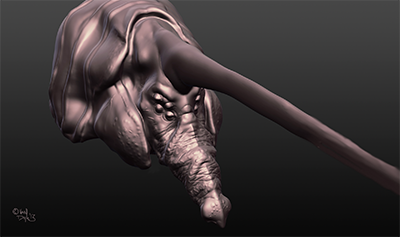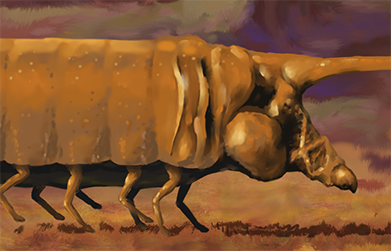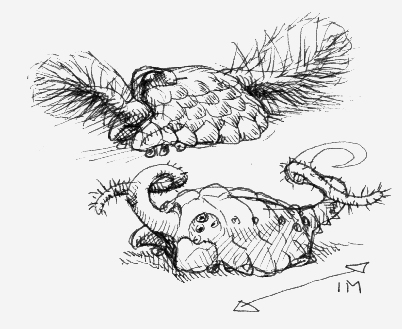More than eight: rusps


|
Rusps
Rusps usually have much more than eight legs, and in that sense are like centipedes or millipedes (which do not have 100 or 1000 legs, by the way). Luckily for us they are not labeled according to the Greek for '24', but simply as 'rusps'. The singular is 'rusp', by the way. Although there is quite a bit of material on rusps on the Furaha blog, no full painting of rusps has ever been published, although they feature on two paintings. Here, only a working model of a rusp head is shown, and a fragment of one digital painting. Those wishing to read more about rusps may well start with the Christmas 2013 blog post, but there are quite a few more.
|
|
Here are two smallish species, only about a meter long. As with many species, the legs are largely hidden from view. Their front and back stingers are very much in evidence though. In these small species stingers really do sting, as they are equipped with venomous hairs. In larger species they are usually non-toxic, but simply strong; all rusps can take quite good care of themselves.
The lower image is a sketch of a rusp and some predators. Rusps are fairly well immune from predators such as parsons, because their armour is not easily broken, and even when it is pierced, one such gap will not kill a rusp. Meanwhile, the parson has a good chance of being blinded or even killed by the whip-like stingers. This does not keep many predators from mobbing immature rusps, as shown here.
|


|

|
Rusp with backwards ripple
There is an enormous number of possible gaits for so many legs, but nature tends towards manageable solutions. One such solution is to walk with small phase differences between successive legs, going front to back. You get interesting patterns if 'leg n' is slightly ahead in phase of the leg 'n+1' directly behind it, or slightly behind. The two differences are whether the ripple will appear to move forwards or backwards, and whether they tend to clump together on the ground or in the air.
A consequence of this clumping tendency is that the legs may bump into one another. Several rusp species have developed a uniquely Furahan solution for this phenomenon, consisting of an offset of one pair towards one side of the animal and of the succeeding pair to the other side. Such rusps leave interesting tracks.
|
|
Rusp with forwards ripple
Here the phase advances in the other direction along the animal. Now, the legs tend to clump together in the air rather than on the ground, and the legs support the body with more even spacing. This is the way most rusps walk.
|

|





